Jason Schneider
the Camera Collector
The Rambunctious Life & Times of Jason Schneider, Part 1
How an eccentric English major became the editor of 2 top photo mags.
By Jason Schneider
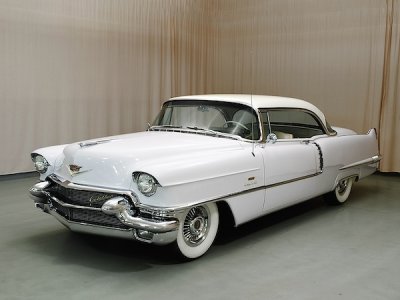
The car not driven to Woodstock. Maybelline, my '56 Cadillac Coupe de Ville, looked as good as this one, but I didn't trust her cooling system.
Back in 1969 I made two fateful decisions that were destined to alter the course of my life. First, I wisely decided not to make the trek to the Woodstock Music Festival because my only vehicle was Maybelline, a great white 1956 Cadillac Coupe de Ville, and I wasn’t about to take the chance of getting stuck in an overheated land yacht on the NY State Thruway. Second, I decided to present my idea for a series of articles on camera collecting to my favorite photo magazines, Modern Photography and Popular Photography. Glenda, my beautiful bride, and I had been married for only a year and we still resided in our first tiny apartment at 194 W. 10th St. in New York’s Greenwich Village. We were both in our ‘20s (sigh) and Glenda was holding down a real job as an Art Teacher in a New York City elementary school (she has an M.A. in Art Education). Meanwhile, I was bouncing around as a freelance photographer, shooting whatever assignments I could get, from weddings and Bar Mitzvahs, to aspiring model’s portfolios, to educational film strips. I wasn’t really looking for a fulltime job, but I thought that by pitching a few articles I might be able to monetize my passion for old cameras and maybe get my name out there.
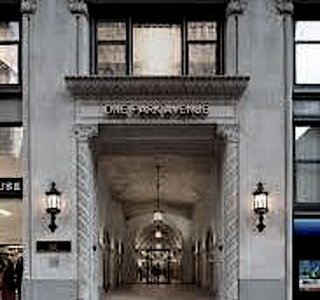
The elegant main entrance to swanky 1 Park Ave., New York where Popular Photograpy's editorial offices were located in 1969.
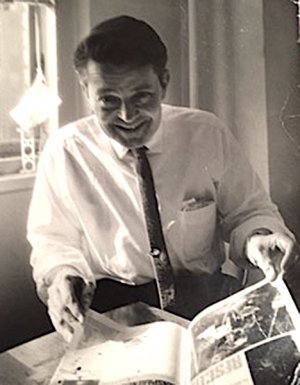
The nice guy who turned me down: The late Ken Poli, longtime editor of Popular Photography, was a stand-up guy and a great journalist.
I bought my first serious camera (an East German Belfoca roll film folder) at age 14 and started buying photo magazines on the newsstand (remember those?) about a year later. I could’ve saved quite a bit by subscribing to both Modern and Pop Photo because I bought 10 out of 12 monthly issues at full retail, but I never did—financial acumen was never my strong suit. Anyway, one fine day in the fall of 1969, I wrote up a proposal (in longhand!), placed a half dozen of my favorite collectible cameras in a ratty old leather camera bag, put on my one and only suit, and marched up to the editorial offices of Popular Photography at 1 Park Ave. Eventually I was escorted into a conference room, briefly met Jim Zanutto, then Editor in Chief, and had a 10-minute sit-down discussion of my proposal with editor Ken Poli, a gracious, soft-spoken man who did his best to let me down easy. “This is really a nice idea, and it may well find a welcome reception at another publication, but it’s not for us,” he concluded, and we shook hands as I departed, hat in hand. But before I could reach the exit, I was accosted by longtime Pop Photo staffer Norman Rothschild who took me aside out of earshot and delivered a shocking tirade, full of unbridled intensity and replete with colorful expletives. The gist of it: “The MF SOBs on this GD magazine wouldn’t know a good idea if it bit them in the leg. Take this over to Burt Keppler at Modern Photography. He will appreciate it!”
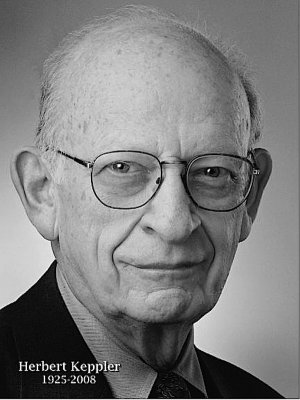
The late, great Herbert (Burt) Keppler, my beloved mentor. He was a great writer, a great man, and a fierce advocate for honesty and integrity.
In retrospect, the most amazing aspect of this story is that I didn’t pitch my idea to Modern Photography in the first place. It was by far my favorite American photo enthusiast publication (though I enjoyed reading Pop Photo, U.S. Camera, and Camera 35) and Herbert (Burt) Keppler was the most engaging and empathetic writer in the field. Anyway, shortly after I made my pitch to Burt Keppler, he gave it the OK and I signed on to do a series of 4 articles. Burt also came up with the title for what eventually became my column that ran in Modern and Pop for over 35 years, The Camera Collector. Burt asked me if I could provide professional photos of all the cameras and of course I said yes even though I didn’t have access to a studio at the time. So, I shot them on the flat tar roof of my 1885 apartment building with a tripod mounted 9 x 12cm Voigtlander Avus film pack camera with a 6 x 9cm Rada roll film adapter, and developed and printed them myself. Result: the cameras appearing in my first 4 column starting in October 1969 are very sharp and detailed, but the harsh direct sunlight didn’t do wonders for their tonal gradation, and they look, well, amateurish. I should have used a reflector, a diffuser, or waited for an overcast day—aka God’s soft box. Kismet.
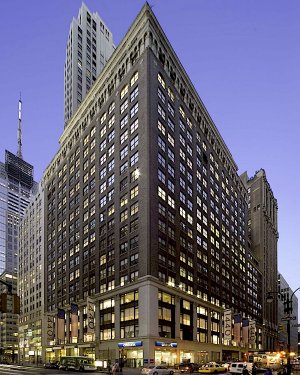
Building at 1440 Broadway where Modern Photgraphy's editorial offices were located in 1969.
Whatever their technical deficiencies may have been, my first Camera Collector columns for Modern Photography were very well received by the readers and were soon expanded into a monthly series. And although I was still only a columnist, I started hanging around Modern’s editorial offices on a regular basis. It was there that I met Jeff McCallum (I hope that’s the right spelling) a bright young guy with some photo science training under his belt, who was running Modern’s test lab under the astute guidance of Bennett Sherman, a PhD in Physics and a genuine expert on optics and mechanical systems. It was Sherman and Keppler who configured Modern’s original test lab and equipped it with, among ither things, a Zelox shutter speed tester, a Zelox exposure (light level) tester, a lens collimator, and a Gaertner optical bench. I got along famously with Jeff since we were both “irreverent and sarcastic young weisenheimers” and he taught me a lot about camera testing and proper lab procedures that would later prove more useful than I could have possibly imagined at the time.
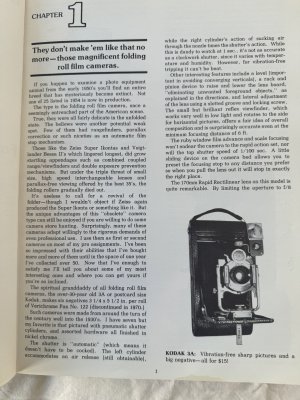
Page 1 of my first Camera Collector column in Modern Photography, Oct. 1969 as republished in Jason Schneider on Camera Collecting No.1.
Sometime in early 1970 Jeff McCallum received a little billet-doux from Uncle Sam notifying him that he was drafted into the U.S. Army and would most likely have to serve in Vietnam. While Jeff was not pleased about having to leave Modern and may have thought about devising some stratagem that would allow him to stay, there was one little problem—his father was a U.S. Army Colonel, and he was evidently a stern guy who called the shots. As a result Jeff departed Modern Photography, presumably for the military (I sure hope he’s still alive and well) and I, who was fortuitously waiting in the wings, was named Assistant Editor at Modern Photography, a fulltime position. I continued to write The Camera Collector column and being an incurable wag and miscreant, at the time I signed all my correspondence Ass. Ed.
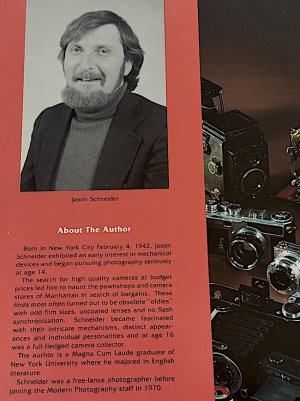
Photo of yours truly in 1978 from back cover of Jason Schneider On Camera Collecting, Book 1.
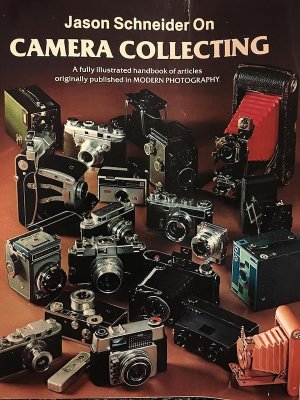
Cover of Jason Schneider on Camera Collecting Book 1, published in 1978. It showcases cameras as the technological works of art they are.
Although I learned a lot working as the de facto lab tech at Modern for about a year and a half, and even devised a couple of improvements to the test procedures (such as through-focus resolution testing at maximum aperture to identify and correct resolution discrepancies) I was overjoyed when Burt Keppler hired a young Japanese technician from the JCII (Japan Camera Inspection Institute) to run the lab. Instituting high level objective camera and lens testing was one of Burt Keppler’s most cherished goals and I am happy to have played some infinitesimal part in achieving it.
How an eccentric English major became the editor of 2 top photo mags.
By Jason Schneider

The car not driven to Woodstock. Maybelline, my '56 Cadillac Coupe de Ville, looked as good as this one, but I didn't trust her cooling system.
Back in 1969 I made two fateful decisions that were destined to alter the course of my life. First, I wisely decided not to make the trek to the Woodstock Music Festival because my only vehicle was Maybelline, a great white 1956 Cadillac Coupe de Ville, and I wasn’t about to take the chance of getting stuck in an overheated land yacht on the NY State Thruway. Second, I decided to present my idea for a series of articles on camera collecting to my favorite photo magazines, Modern Photography and Popular Photography. Glenda, my beautiful bride, and I had been married for only a year and we still resided in our first tiny apartment at 194 W. 10th St. in New York’s Greenwich Village. We were both in our ‘20s (sigh) and Glenda was holding down a real job as an Art Teacher in a New York City elementary school (she has an M.A. in Art Education). Meanwhile, I was bouncing around as a freelance photographer, shooting whatever assignments I could get, from weddings and Bar Mitzvahs, to aspiring model’s portfolios, to educational film strips. I wasn’t really looking for a fulltime job, but I thought that by pitching a few articles I might be able to monetize my passion for old cameras and maybe get my name out there.

The elegant main entrance to swanky 1 Park Ave., New York where Popular Photograpy's editorial offices were located in 1969.

The nice guy who turned me down: The late Ken Poli, longtime editor of Popular Photography, was a stand-up guy and a great journalist.
I bought my first serious camera (an East German Belfoca roll film folder) at age 14 and started buying photo magazines on the newsstand (remember those?) about a year later. I could’ve saved quite a bit by subscribing to both Modern and Pop Photo because I bought 10 out of 12 monthly issues at full retail, but I never did—financial acumen was never my strong suit. Anyway, one fine day in the fall of 1969, I wrote up a proposal (in longhand!), placed a half dozen of my favorite collectible cameras in a ratty old leather camera bag, put on my one and only suit, and marched up to the editorial offices of Popular Photography at 1 Park Ave. Eventually I was escorted into a conference room, briefly met Jim Zanutto, then Editor in Chief, and had a 10-minute sit-down discussion of my proposal with editor Ken Poli, a gracious, soft-spoken man who did his best to let me down easy. “This is really a nice idea, and it may well find a welcome reception at another publication, but it’s not for us,” he concluded, and we shook hands as I departed, hat in hand. But before I could reach the exit, I was accosted by longtime Pop Photo staffer Norman Rothschild who took me aside out of earshot and delivered a shocking tirade, full of unbridled intensity and replete with colorful expletives. The gist of it: “The MF SOBs on this GD magazine wouldn’t know a good idea if it bit them in the leg. Take this over to Burt Keppler at Modern Photography. He will appreciate it!”

The late, great Herbert (Burt) Keppler, my beloved mentor. He was a great writer, a great man, and a fierce advocate for honesty and integrity.
In retrospect, the most amazing aspect of this story is that I didn’t pitch my idea to Modern Photography in the first place. It was by far my favorite American photo enthusiast publication (though I enjoyed reading Pop Photo, U.S. Camera, and Camera 35) and Herbert (Burt) Keppler was the most engaging and empathetic writer in the field. Anyway, shortly after I made my pitch to Burt Keppler, he gave it the OK and I signed on to do a series of 4 articles. Burt also came up with the title for what eventually became my column that ran in Modern and Pop for over 35 years, The Camera Collector. Burt asked me if I could provide professional photos of all the cameras and of course I said yes even though I didn’t have access to a studio at the time. So, I shot them on the flat tar roof of my 1885 apartment building with a tripod mounted 9 x 12cm Voigtlander Avus film pack camera with a 6 x 9cm Rada roll film adapter, and developed and printed them myself. Result: the cameras appearing in my first 4 column starting in October 1969 are very sharp and detailed, but the harsh direct sunlight didn’t do wonders for their tonal gradation, and they look, well, amateurish. I should have used a reflector, a diffuser, or waited for an overcast day—aka God’s soft box. Kismet.

Building at 1440 Broadway where Modern Photgraphy's editorial offices were located in 1969.
Whatever their technical deficiencies may have been, my first Camera Collector columns for Modern Photography were very well received by the readers and were soon expanded into a monthly series. And although I was still only a columnist, I started hanging around Modern’s editorial offices on a regular basis. It was there that I met Jeff McCallum (I hope that’s the right spelling) a bright young guy with some photo science training under his belt, who was running Modern’s test lab under the astute guidance of Bennett Sherman, a PhD in Physics and a genuine expert on optics and mechanical systems. It was Sherman and Keppler who configured Modern’s original test lab and equipped it with, among ither things, a Zelox shutter speed tester, a Zelox exposure (light level) tester, a lens collimator, and a Gaertner optical bench. I got along famously with Jeff since we were both “irreverent and sarcastic young weisenheimers” and he taught me a lot about camera testing and proper lab procedures that would later prove more useful than I could have possibly imagined at the time.

Page 1 of my first Camera Collector column in Modern Photography, Oct. 1969 as republished in Jason Schneider on Camera Collecting No.1.
Sometime in early 1970 Jeff McCallum received a little billet-doux from Uncle Sam notifying him that he was drafted into the U.S. Army and would most likely have to serve in Vietnam. While Jeff was not pleased about having to leave Modern and may have thought about devising some stratagem that would allow him to stay, there was one little problem—his father was a U.S. Army Colonel, and he was evidently a stern guy who called the shots. As a result Jeff departed Modern Photography, presumably for the military (I sure hope he’s still alive and well) and I, who was fortuitously waiting in the wings, was named Assistant Editor at Modern Photography, a fulltime position. I continued to write The Camera Collector column and being an incurable wag and miscreant, at the time I signed all my correspondence Ass. Ed.

Photo of yours truly in 1978 from back cover of Jason Schneider On Camera Collecting, Book 1.

Cover of Jason Schneider on Camera Collecting Book 1, published in 1978. It showcases cameras as the technological works of art they are.
Although I learned a lot working as the de facto lab tech at Modern for about a year and a half, and even devised a couple of improvements to the test procedures (such as through-focus resolution testing at maximum aperture to identify and correct resolution discrepancies) I was overjoyed when Burt Keppler hired a young Japanese technician from the JCII (Japan Camera Inspection Institute) to run the lab. Instituting high level objective camera and lens testing was one of Burt Keppler’s most cherished goals and I am happy to have played some infinitesimal part in achieving it.
Last edited:
Ororaro
Well-known
Congrats’
You’re a true champ.
You’re a true champ.
Jason Schneider
the Camera Collector
Thanks for your kind words, but I owe it all to Wheaties, the breakfast of champions.Congrats’
You’re a true champ.
AlwaysOnAuto
Well-known
I probably have one or two of those issues somewhere stored away. That is about the time I was thinking, wow, wouldn't it be neat to do camera collecting and writing as a JOB.
Only thing better would have been being a motorcycle magazine writer and getting to ride all the latest and greatest bikes of the time.
Thanks for the insights into your life and keep the articles coming!
Only thing better would have been being a motorcycle magazine writer and getting to ride all the latest and greatest bikes of the time.
Thanks for the insights into your life and keep the articles coming!
Muggins
Junk magnet
A very impressive and eclectic selection on that cover - do I see a Rajar at the back? Can't be many of those in the USA.
And what the hell was that automatic exposure Kodak (one down from top left) called - other than "the boomerang" by the repair guys?
And what the hell was that automatic exposure Kodak (one down from top left) called - other than "the boomerang" by the repair guys?
Jason Schneider
the Camera Collector
Thanks for your thoughts and kind words. I was a certified motorcycle fanatic from age 16 (1958) when I got my first bike, an NSU Supermax 250 for the grand sum of $115 (cuz nobody else wanted it), to when I hung up my helmet in 2016 after I was mowed down head-on by a 95 year old coot driving an oversized Dodge Ram pickup truck (the bike was totaled and my left leg was broken at the tibial plateau). I have only 2 questions about my 58-year stint on two wheels (which included 24 two-way, cross-country tours of the USA): Why did I ever sell my mint mint 1958 Harley-Davidson Panhead, and my pristine Ducati 750SS?!I probably have one or two of those issues somewhere stored away. That is about the time I was thinking, wow, wouldn't it be neat to do camera collecting and writing as a JOB.
Only thing better would have been being a motorcycle magazine writer and getting to ride all the latest and greatest bikes of the time.
Thanks for the insights into your life and keep the articles coming!
Mackinaw
Think Different
Another great piece. Keep 'em coming. One question. What happened to the '56 Caddy?
Jim B.
Jim B.
Jason Schneider
the Camera Collector
I bought the '56 Caddy from an estate sale (advertised in the Sunday NY Times Classic Car section) and drove through a snowstorm so I could be be the first buyer to hand the seller full payment in cash--$275.00. It had 80.000 original miles on it and had been fully restored by the local (New Jersey) Cadillac agency at the behest of an old coot who then died before he could enjoy it. I drove it for a happy, trouble free 40,000 miles, but then the transmission started making expensive noises, so I sold it to a bona fide Cadillac collector for $550.00 as a fixer-upper. It was thus the most "economical" car I've ever owned and it even got 16 MPG on the road. Not great for going around tight corners, but a dream on the super-slab at 80MPH. It had no AC, but did have an automatic headlight dimmer and a signal seeking AM radio. Happy days.Another great piece. Keep 'em coming. One question. What happened to the '56 Caddy?
Jim B.
Last edited:
Jason Schneider
the Camera Collector
Sorry I can't positively identify the folding strut camera you refer to--the cover image is too soft--but if memory serves it was German, not the similar looking bakelite Rajah that was made in England. "That Kodak" is the renowned Kodak Super 620 of 1938, a roll film folder that was the world's first auto-exposure still camera. It was expensive and no paragon of reliability, but I do like its cool art deco styling,A very impressive and eclectic selection on that cover - do I see a Rajar at the back? Can't be many of those in the USA.
And what the hell was that automatic exposure Kodak (one down from top left) called - other than "the boomerang" by the repair guys?
hilltime
Well-known
If those cameras on the mag cover were yours, how many do you still own?
Jason Schneider
the Camera Collector
I only owned about 1/3 of the cameras shown on the cover of my Book 1, and I still own about 10% of the cameras I’ve ever written about in the Camera Collector column. My current collection includes 212 cameras and it’s holding pretty steady despite the anguished pleas of my wife to sell a bunch. BTW there are hundreds of U.S. collectors who have a lot more cameras than I do. There’s one (anonymous) collector I know who has 7,000 cameras!If those cameras on the mag cover were yours, how many do you still own?
This is a true relief for me.I only owned about 1/3 of the cameras shown on the cover of my Book 1, and I still own about 10% of the cameras I’ve ever written about in the Camera Collector column. My current collection includes 212 cameras and it’s holding pretty steady despite the anguished pleas of my wife to sell a bunch. BTW there are hundreds of U.S. collectors who have a lot more cameras than I do. There’s one (anonymous) collector I know who has 7,000 cameras!
I can show this to my wife and claim that I am not soooo badddd......
So- I started reading The Camera Collector the second year it was in publication. And afflicted for life...
DownUnder
Nikon Nomad
This is truly wonderful, and historically so valuable. Sadly very little has been written about the photo media of the 1960s and 1970s. More will be welcome, and it seems you are the author to do it. Well done!
I recall your first column in Modern Photography - was it as long ago as 1969? - and I have your 'classic' book in my library. So we both of us go back a long way.
I was a US Camera subscriber from 1964 but like everybody else I bought Modern and Pop at our local pharmacy - then known as a "drug store" but in this less innocent day and age the term has more sinister meanings so it may no longer be in the lexicon. This same 'chemist' (this being the Aussie term) in 1966 sold me an off-the-shelf Rolleiflex 3.5E2, which has been ordered by our local dentist who sadly passed away before he could claim it and pay the balance. His widow, a family friend, kindly donated the deposit and I recall I paid the balance of CDN $195.00 for it, one of my life's great bargains even if the Canuck buck was then worth more than the Yankee dolla, CDN $1.04/US$1.00 IRRC. I don't remember if you ever wrote about the Rollei TLRs which have been one of my (far many) lifelong loves, but you've covered just about every camera ever made so it's likely yes. I must look up TLRs in your book and see for myself.
Camera collecting now. In my time I had somewhere between 45 and 60 - I always hesitated to count them for fear of retribution from my spouse who always frowned on my indulgence in old gear but kindly and lovingly put up with it - but after retiring in 2012 I steadily reduced the numbers to about 15. All my Hasselblads went, but I've kept the Nikons (well, Nikkormats), the '50s German folders, and of course the Rolleis. more. A few odd bod cameras yet to go, last year I offloaded three Contax G1s to a user-collector in Japan so I now have only one. Stayed true to the faith with digital Nikons but this is about analog and I will say no more about this heresy...
There were so many great people on all the American photo magazines. I fondly remember Julia Scully, who sadly left us last year at a great age Norman Rothschild, and of course Burt Keppler who is to this day one of the great legends of the medium. Also an endearingly eccentric photo writer named Bob Schwalberg (I may have his name wrong here, my memory not being what it was half a ccentury ago, if so then will someone please correct me) now long forgotten but in his time in the '50s and '60s a prolific author, who I envied as he had a Leica M3 which I coveted for many years and finally bought one with a superb LeitzSummarit 50/1.5 in 1986 (sadly both sold, for which I still kick myself). So go the memories of my lifetime, I have many more but this post is more about Jason's life andhis cameras, not my own reminiscences.
Amazing to discover you are over 80. I know you've been around and writing great stuff since the Ark, but have all those decades flown by so quickly? In your time you've written so much, and today here you are still grinding out all the gorgeous prose for us to enjoy.
This said, you are still with us and still writing. May we both continue to go on going on as we do, for a very long time to come.
I recall your first column in Modern Photography - was it as long ago as 1969? - and I have your 'classic' book in my library. So we both of us go back a long way.
I was a US Camera subscriber from 1964 but like everybody else I bought Modern and Pop at our local pharmacy - then known as a "drug store" but in this less innocent day and age the term has more sinister meanings so it may no longer be in the lexicon. This same 'chemist' (this being the Aussie term) in 1966 sold me an off-the-shelf Rolleiflex 3.5E2, which has been ordered by our local dentist who sadly passed away before he could claim it and pay the balance. His widow, a family friend, kindly donated the deposit and I recall I paid the balance of CDN $195.00 for it, one of my life's great bargains even if the Canuck buck was then worth more than the Yankee dolla, CDN $1.04/US$1.00 IRRC. I don't remember if you ever wrote about the Rollei TLRs which have been one of my (far many) lifelong loves, but you've covered just about every camera ever made so it's likely yes. I must look up TLRs in your book and see for myself.
Camera collecting now. In my time I had somewhere between 45 and 60 - I always hesitated to count them for fear of retribution from my spouse who always frowned on my indulgence in old gear but kindly and lovingly put up with it - but after retiring in 2012 I steadily reduced the numbers to about 15. All my Hasselblads went, but I've kept the Nikons (well, Nikkormats), the '50s German folders, and of course the Rolleis. more. A few odd bod cameras yet to go, last year I offloaded three Contax G1s to a user-collector in Japan so I now have only one. Stayed true to the faith with digital Nikons but this is about analog and I will say no more about this heresy...
There were so many great people on all the American photo magazines. I fondly remember Julia Scully, who sadly left us last year at a great age Norman Rothschild, and of course Burt Keppler who is to this day one of the great legends of the medium. Also an endearingly eccentric photo writer named Bob Schwalberg (I may have his name wrong here, my memory not being what it was half a ccentury ago, if so then will someone please correct me) now long forgotten but in his time in the '50s and '60s a prolific author, who I envied as he had a Leica M3 which I coveted for many years and finally bought one with a superb LeitzSummarit 50/1.5 in 1986 (sadly both sold, for which I still kick myself). So go the memories of my lifetime, I have many more but this post is more about Jason's life andhis cameras, not my own reminiscences.
Amazing to discover you are over 80. I know you've been around and writing great stuff since the Ark, but have all those decades flown by so quickly? In your time you've written so much, and today here you are still grinding out all the gorgeous prose for us to enjoy.
This said, you are still with us and still writing. May we both continue to go on going on as we do, for a very long time to come.
Tim Read
Established
DownUnder, that is a very fine post about JS. Thank you and thanks JS from another DownUnder person (Bondi Beach, Sydney) who has also been giving cameras away but from a much smaller base number. I have kept my Rollicord V but alas have not used it for long time having become a heretic and largely gone over to the digital realm. I plead my case for leniency in sentencing by saying that I have adapters for all my "legacy" lenses which go very well on my Sony a7iii.
DownUnder
Nikon Nomad
Tim, my far my favorite TLR is a Rolleicord Vb I bought as a kit from a deceased estate a few years ago, at a giveaway price - the widow took a shine to me and understood that I intended to use the camera and not flip it on Ebay, so she discounted it, being suitably well off anyway that the sale wasn't a survival one for her. I am ever thankful to her for this and yes, we stay in contact and meet on occasion for a nice lunch and some good Pyrenees wine in Maryborough.
A small correction to my previous post. Bob Schwalberg was in fact the correct name and person, 1927-1996, with Modern Photography from 1950 and a prolific writer awith his his own unique style, if not as ambitious or technically accurate (I did catch him out in a few minor errors in his 1960s articles) as our JS is.
Bob Schwalberg is well represented online as I discovered when I finally made the effort to do a few accurately keyworded Google searches. Even on the Yale Centre for British Art which I reckon would be no small achievement. His current avatar must be proud indeed.
Legacy lenses can be fine optics. I have four Contax G Zeiss (made in Japan, never mind) I want to adapt to use on one of my Nikons, but I've yet to find an adapter I can afford - I prefer Metabones and those ain't cheap as you surely would know. One of these days I'll luck into one at a good price and as we say out in the bush, Bob's your uncle. Was that Menzies by any chance?
A small correction to my previous post. Bob Schwalberg was in fact the correct name and person, 1927-1996, with Modern Photography from 1950 and a prolific writer awith his his own unique style, if not as ambitious or technically accurate (I did catch him out in a few minor errors in his 1960s articles) as our JS is.
Bob Schwalberg is well represented online as I discovered when I finally made the effort to do a few accurately keyworded Google searches. Even on the Yale Centre for British Art which I reckon would be no small achievement. His current avatar must be proud indeed.
Legacy lenses can be fine optics. I have four Contax G Zeiss (made in Japan, never mind) I want to adapt to use on one of my Nikons, but I've yet to find an adapter I can afford - I prefer Metabones and those ain't cheap as you surely would know. One of these days I'll luck into one at a good price and as we say out in the bush, Bob's your uncle. Was that Menzies by any chance?
Muggins
Junk magnet
Thank you, Jason. That clamshell case is so distinctive, I recognised it instantly, just couldn't get the name drom where it was lodged in my brain.Sorry I can't positively identify the folding strut camera you refer to--the cover image is too soft--but if memory serves it was German, not the similar looking bakelite Rajah that was made in England. "That Kodak" is the renowned Kodak Super 620 of 1938, a roll film folder that was the world's first auto-exposure still camera. It was expensive and no paragon of reliability, but I do like its cool art deco styling,
froyd
Mentor
What a great read. Thanks for sharing the story!
davidswiss
Established
Thank you. Jason. for writing that. Interesting and entertaining.
Jason Schneider
the Camera Collector
Thanks so much for your joyous and wistful reminiscences, and your kind words. Rolleiflex TLRs are among the finest cameras ever made, but I most often use my great hulking clunkers, a Mamiyaflex C and C2, these days because they focus down to 18 inches without requiring Rolleinars. Keep shooting film in your remaining vintage classics!This is truly wonderful, and historically so valuable. Sadly very little has been written about the photo media of the 1960s and 1970s. More will be welcome, and it seems you are the author to do it. Well done!
I recall your first column in Modern Photography - was it as long ago as 1969? - and I have your 'classic' book in my library. So we both of us go back a long way.
I was a US Camera subscriber from 1964 but like everybody else I bought Modern and Pop at our local pharmacy - then known as a "drug store" but in this less innocent day and age the term has more sinister meanings so it may no longer be in the lexicon. This same 'chemist' (this being the Aussie term) in 1966 sold me an off-the-shelf Rolleiflex 3.5E2, which has been ordered by our local dentist who sadly passed away before he could claim it and pay the balance. His widow, a family friend, kindly donated the deposit and I recall I paid the balance of CDN $195.00 for it, one of my life's great bargains even if the Canuck buck was then worth more than the Yankee dolla, CDN $1.04/US$1.00 IRRC. I don't remember if you ever wrote about the Rollei TLRs which have been one of my (far many) lifelong loves, but you've covered just about every camera ever made so it's likely yes. I must look up TLRs in your book and see for myself.
Camera collecting now. In my time I had somewhere between 45 and 60 - I always hesitated to count them for fear of retribution from my spouse who always frowned on my indulgence in old gear but kindly and lovingly put up with it - but after retiring in 2012 I steadily reduced the numbers to about 15. All my Hasselblads went, but I've kept the Nikons (well, Nikkormats), the '50s German folders, and of course the Rolleis. more. A few odd bod cameras yet to go, last year I offloaded three Contax G1s to a user-collector in Japan so I now have only one. Stayed true to the faith with digital Nikons but this is about analog and I will say no more about this heresy...
There were so many great people on all the American photo magazines. I fondly remember Julia Scully, who sadly left us last year at a great age Norman Rothschild, and of course Burt Keppler who is to this day one of the great legends of the medium. Also an endearingly eccentric photo writer named Bob Schwalberg (I may have his name wrong here, my memory not being what it was half a ccentury ago, if so then will someone please correct me) now long forgotten but in his time in the '50s and '60s a prolific author, who I envied as he had a Leica M3 which I coveted for many years and finally bought one with a superb LeitzSummarit 50/1.5 in 1986 (sadly both sold, for which I still kick myself). So go the memories of my lifetime, I have many more but this post is more about Jason's life andhis cameras, not my own reminiscences.
Amazing to discover you are over 80. I know you've been around and writing great stuff since the Ark, but have all those decades flown by so quickly? In your time you've written so much, and today here you are still grinding out all the gorgeous prose for us to enjoy.
This said, you are still with us and still writing. May we both continue to go on going on as we do, for a very long time to come.
Jason Schneider
the Camera Collector
Thanks for your refresh on Bob Schwalberg, an excellent writer with a savagely ironic sense of humor and a very competent tech. I am sure if you scoured my early columns, researched on the fly in pre-internet days, you’d find that I’ve made at least as many errors as Bob. Now there’s a grim assignment for you-Tim, my far my favorite TLR is a Rolleicord Vb I bought as a kit from a deceased estate a few years ago, at a giveaway price - the widow took a shine to me and understood that I intended to use the camera and not flip it on Ebay, so she discounted it, being suitably well off anyway that the sale wasn't a survival one for her. I am ever thankful to her for this and yes, we stay in contact and meet on occasion for a nice lunch and some good Pyrenees wine in Maryborough.
A small correction to my previous post. Bob Schwalberg was in fact the correct name and person, 1927-1996, with Modern Photography from 1950 and a prolific writer awith his his own unique style, if not as ambitious or technically accurate (I did catch him out in a few minor errors in his 1960s articles) as our JS is.
Bob Schwalberg is well represented online as I discovered when I finally made the effort to do a few accurately keyworded Google searches. Even on the Yale Centre for British Art which I reckon would be no small achievement. His current avatar must be proud indeed.
Legacy lenses can be fine optics. I have four Contax G Zeiss (made in Japan, never mind) I want to adapt to use on one of my Nikons, but I've yet to find an adapter I can afford - I prefer Metabones and those ain't cheap as you surely would know. One of these days I'll luck into one at a good price and as we say out in the bush, Bob's your uncle. Was that Menzies by any chance?
Share:
-
This site uses cookies to help personalise content, tailor your experience and to keep you logged in if you register.
By continuing to use this site, you are consenting to our use of cookies.

